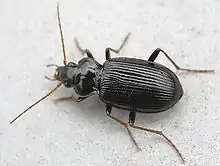| Nebria brevicollis | |
|---|---|
 | |
| Nebria brevicollis | |
| Scientific classification | |
| Kingdom: | |
| Phylum: | |
| Class: | |
| Order: | |
| Suborder: | |
| Family: | |
| Subfamily: | |
| Genus: | |
| Subgenus: | Nebria (Nebria) |
| Species: | N. brevicollis |
| Binomial name | |
| Nebria brevicollis (Fabricius, 1792) | |
Nebria brevicollis is a species of ground beetle native to Europe and the Near East, but introduced to the western United States[1] and Canada.[2]
Description
Nebria brevicollis has a body which is dark brown, with reddish-brown on the tibiae, tarsi, palpi and antennae. The pronotum has two lateral setae on either side, and is densely punctuate across the entire base.[2]
Range
In Europe, it is found in all countries and islands except the Azores, the Canary Islands, the Channel Islands, Franz Josef Land, Gibraltar, Madeira, Malta, Monaco, the North Aegean Islands, Novaya Zemlya, San Marino, the Selvagens Islands, Svalbard and Jan Mayen, and Vatican City.[3]
In 2008, it was reported as introduced in western Oregon, U.S.A.,[1] where it has been found in highly disturbed sites as well as in native old-growth forest stands. It has also now been found in Washington State,[4] Northern California, as well as in southern British Columbia, Canada.[2]
Habitat
The primary habitat is the cover of shaded leaf litter in deciduous forests; however, it can also be found in disturbed habitat such as parks, gardens, and agricultural lands. In North America, it has found in the summits, forest and meadows of mountains (at over 1200 metres elevation).[4] Unlike other members of Nebria, this species avoids moist areas.[1]
Ecology
This species is most abundant between October and December, then from January through mid-May.

The species is preyed upon by the fungus Erynia nebriae.[5]
Although Nebria brevicollis is widely considered to be solely carnivorous, multiple small studies made by enthusiasts have proven that many Nebria brevicollis will resort to eating various types of fungi that can be found in the soil they live on/around. Studied made by the same individuals have also shown that Nebria brevicollis are semi-social, and will often work together when faced with certain obstacles.
Behaviour
A study found evidence of personality in N. brevicollis, identifying repeatable, consistent differences in seven behavioural traits between individuals.[6]
References
- 1 2 3 Kavanaugh, David H.; LaBonte, James R. "Discovery of Nebria brevicollis (Fabricius) (Coleoptera: Carabidae: Nebriini), a European Ground Beetle, Established in the Willamette Valley, Oregon" (PDF). Proceedings of the California Academy of Sciences. 59 (9): 481–488. Retrieved November 19, 2023.
- 1 2 3 McGregor, Robert R.; Goulet, Henri; LaBonte, James R. (18 December 2020). "First western Canadian records of Nebria brevicollis (Coleoptera: Carabidae) and establishment of populations in Coquitlam, British Columbia, Canada". The Canadian Entomologist. 153 (2): 237–243. doi:10.4039/tce.2020.72. ISSN 0008-347X.
- ↑ "Nebria (Nebria) brevicollis (Fabricius, 1792)". 2.6.2. Fauna Europaea. August 29, 2013. Archived from the original on November 13, 2013. Retrieved November 13, 2013.
- 1 2 LaBonte, James (2011-11-16). "Nebria brevicollis (Fabricius, 1792) in North America, benign or malign? (Coleoptera, Carabidae, Nebriini)". ZooKeys (147): 527–543. doi:10.3897/zookeys.147.2119. ISSN 1313-2970. PMC 3286253. PMID 22371674.
- ↑ Keller, Siegfried; Hülsewig, Thorben (2018-01-05). "Amended description and new combination for Entomophthora nebriae Raunkiaer, (1893), a little known entomopathogenic fungus attacking the ground beetle Nebria brevicollis (Fabricius, 1792)". Alpine Entomology. 2: 1–5. doi:10.3897/alpento.2.22136. ISSN 2535-0889.
- ↑ Labaude, Sophie; O’Donnell, Niamh; Griffin, Christine T. (2018-11-30). "Description of a personality syndrome in a common and invasive ground beetle (Coleoptera: Carabidae)". Scientific Reports. 8 (1): 17479. doi:10.1038/s41598-018-35569-z. ISSN 2045-2322. PMC 6269510.
External links
- Nebria brevicollis at Vancouver, Clark Co., Washington, U.S.A.
 Media related to Nebria brevicollis at Wikimedia Commons
Media related to Nebria brevicollis at Wikimedia Commons Data related to Nebria brevicollis at Wikispecies
Data related to Nebria brevicollis at Wikispecies